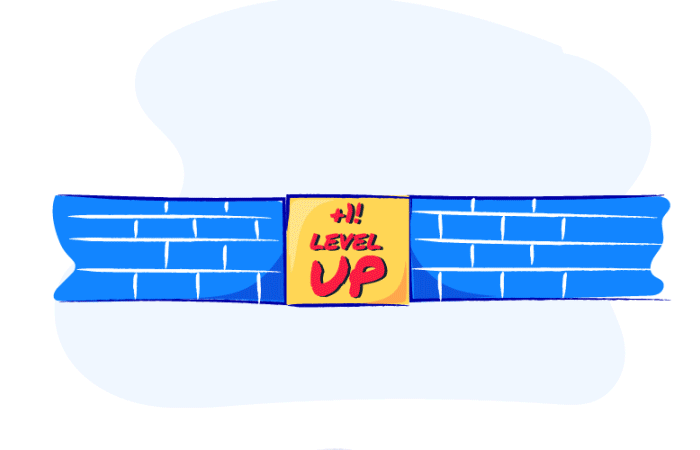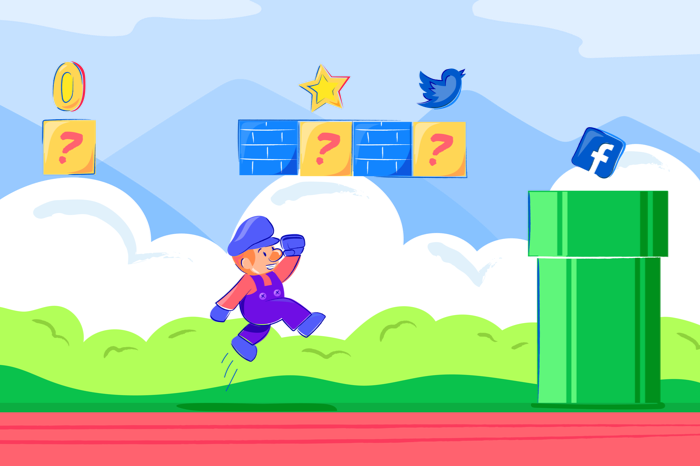Gamification can easily be applied to your online course and has actually proven to increase engagement and drive referrals — that’s why so many companies are leveraging its power. For example, Fitbit incorporated gamification by gifting “badges” to users when they hit certain fitness goals, introducing social challenges, and incorporating a visual progress bar.

By adding a fun element to your online course, you are creating motivation and inspiring engagement in a new, refreshing way. In fact, gamification features are said to boost engagement by 60%, which is convincing enough to start considering adding game-like experiences to your courses.
Why gamification?
Taking an online course can be a lot like drinking from a fire hose. As rich in value as it may be, it’s often an overwhelming experience offering too much to absorb with too little motivation to finish.
Gamification is not about packing more “stuff” onto your existing online courses; it’s about thinking through the learning experience that you want to create for your customers.
By adding one or all of the following gamification concepts to the design of your next online course, you’ll raise the bar for your customers and ensure they’ll keep coming back for more.
1. Progress tracking adds a new level of motivation
The idea behind progress tracking is simple: Most people are motivated by achievement. Why not show people their progress and reward them incrementally as they move through your course?
In most learning environments, students absorb information on their own — in isolation. Without indicators of how much they’ve completed and what’s left to get through, it can be a lonely proposition that many learners abandon or give up on.
With even the simplest progress tracking tool in place, students can check off the modules and tasks they’ve completed which increases satisfaction and feelings of accomplishment.
2. Social sharing increases buy-in and engagement
If achieving something is motivating in itself, sharing your success with others is even more powerful. By adding a social sharing component to your online courses, you make it almost irresistible for learners to celebrate their successes along the way, which then inspires them to keep going.
You can do this by awarding badges when students complete modules or mini courses, and you can implement a “share on social media” button that gives them the ability to show off their progress.
The added bonus to you as a course creator is that when students share their course achievements, they’re also building buzz and organically generating word-of-mouth marketing for you.
3. Unlocking content based on actions and following up with slower students
One tricky course creation decision that online content creators face is whether to deliver their courses in a “drip” format — where a new module is released on a weekly basis — or to give access to an entire course up front.
Gamification opens the door to the best of both worlds and gives your students the ability to move through a course at their own pace. If they’re keen students or they happen to have time set aside to go through your program now, they can quickly unlock content as they check off the progress items.
On the flip side, for students who sign up for your course but haven’t reached any of their progress objectives or interacted with any of your materials, you can set up automated emails to follow up with them and check in, motivating them to log in and keep going.
This type of individualized course release schedule means that students get to learn at their own pace, allowing for a personalized learning experience that customers will want to tell their friends about.
4. Gamified quizzes provide instant feedback
The main drawback of an online course is the loss of immediacy: You’re not sitting in front of a live teacher who can assess whether or not you’re grasping a topic or making headway. With gamified quizzes, you, the teacher, can build in checkpoints to see how your students are faring with your course materials.
There’s a tendency to want to make quizzes or tests that reflect the types of assessment exams we all took in school, but the idea behind using gamification to quiz your students is to motivate them by showing them how much they’ve already learned.
You can combine a quiz with social sharing or unlocking badges, which gives students something to look forward to after completing a challenge. Quizzes can also be used as the key to unlock the next piece of content in your course. This provides your learners with instant feedback on their understanding of the course concepts.
5. Wrap your course into a compelling story
There’s a reason that the entertainment industry is a billion dollar business: We’re endlessly fascinated by stories. We love a good storyline in a movie, a book or a video game, so why would an online course be any different?
This is where you can get creative in designing your course. You can craft a narrative for your students to go through as they unlock course modules, complete challenges or quizzes, and share their victories on social media.
The way you design your course interface also matters. If you’re creating a course where the student plays the role of a young orphan who needs to learn how to book flights across the globe to find his parents, drop Easter eggs and hints throughout your membership site with tidbits about where to travel next. Your curriculum can focus on how to book flights using airline points or around-the-world tickets.
Another option is to design your online course to have a “choose your own adventure” feel so that learning modules aren’t sequential but rather recommended based on the individual’s needs.
6. Earning points for taking action and leveling up with bonuses
If there’s one thing that video games have trained us to love, it’s earning points and rewards. With gamification, you can reward your students for the actions they take by giving them points or credits.
These points can be redeemed for prizes such as bonus footage or advanced course materials. Depending on your course topic, you can even offer additional done-for-you resources or access to other perks that can only be unlocked with points.
This type of point system is extremely effective in many industries, from hotel chains to retail stores. There’s something fun about rewarding your most active and engaged customers with more goodies, and it’s never been easier to implement a points system than in today’s digital age.
Pro tip: You might also want to think about implementing a leaderboard to showcase your top students and to tap into learners’ competitive sides.
7. Increasing challenges and built-in accountability
One way to increase students’ confidence in their learning abilities is to give them ways to win while ramping up the challenges you present over time.
For example, start with a simple topic and quiz, which gives a student a boost in morale. Then follow that with a more advanced topic, giving students the ability to test their newfound skill levels.
Just as a video game increases in complexity, you want to design your online course to match the new abilities of your learners as they continue to absorb more information and master more skills.
With these seven gamification strategies, you are sure to take your online course experience to the next level, all while driving more course sales and strong word of mouth.
